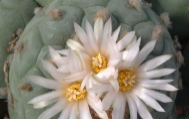Care of Lophophora
The Lophophora genus populates an enormous area of distribution, which is only exceeded by Echinocactus horizontalonius. Compared to many other genera of cacti, this indicates a high level of adaptability. To ensure a natural form [habit] and healthy growth, a few important prerequisites should be met nevertheless. The site should face at least toward the southeast or southwest, better yet toward the south. At the site, the plants usually grow under the protection of Larrea tridentata, Prosopis juliflora, Hechtia glomerata, Fouquieria splendens, and Jatropha dioica. Often on the stem. Even if the accompanying growth is bare during the dry period, these plants provide protection from direct sunlight (diffuse, broken sunlight).
Nevertheless, Lophophora can be found without accompanying growth, which is fully exposed to the sunlight. What is striking is the fact that these plants then exhibit a particularly beautiful blue-green epidermis. Under glass, the plants must be protected from sunburn during midday; this is particularly important if the plants are relocated. Good ventilation must also be provided. If protection from rain is guaranteed, Lophophora can also be out in the open during the summer months. During the growth period at temperatures above 20 degrees Celsius, sufficient watering must be provided, which should be alternated with dry periods.
I only water my Lophophora from below, so that the wool formation remains intact. The plants should only get enough water so that it will be absorbed after a half hour. Rewatering should only be done after it has completely dried out.
The interval between watering stages depends very much on the size of the pot and the temperature and can therefore vary greatly. Waterlogging is not tolerated and the Lophophora can easily burst in this case. Well-rooted plants can be fertilized with a cactus fertilizer of approx. 1 gr/liter of water. Lophophora has the longest bloom time of all cacti. They bloom in batches from the start of the Christmas season until fall. In the ground Lophophora needs a mineral mixture with approx. 5-10% clay admixture. Humous earth is not tolerated for a long time after the seedling stage and a total deficiency can be expected. The winter stand should be as bright as possible with total dryness, with the temperature not dropping below 1 degree Celsius. The Lophophora can lose half of its volume during the winter without a problem, and may then become soft and crinkly. The previous condition can be quickly restored by watering the new growth stage one time. If the location where the plant is set up is not optimal, two-spotted spider mites or more rarely mealybugs can appear on pests, which can be eliminated using the appropriate products from a specialist store.




